37 found, showing page 2 of 3
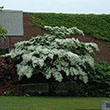
The 'Lustgarten' is a weeping variety with a rounded growth habit. Its cascading branches are covered in large, white blossoms in late spring and in the fall, its rich, green foliage ages to brick red. This variety will grow 8-10' tall and wide. Peeling gray bark adds winter interest.
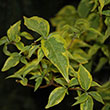
The 'Summer Gold' variety is known for its bright green foliage that is variegated with yellow margins. Foliage turns brilliant red with yellow-orange margins in the fall. This small tree will slowly reach 8-10' tall and 4-6' wide, but has been known to reach 15' tall and wide when planted in ideal conditions. Creamy white flowers emerge in the spring.
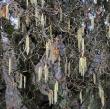
The Harry Lauder's Walking Stick is prized for its winter appearance, with thick, contorting branches and drooping, yellow catkins that appear on the stems in late winter. They have broadly, ovate green leaves from spring through fall. Will grow 8-10' tall and wide.

Plants are vigorous, producing long shoots from soil level one growing season and bearing fruit the next. These are removed after bearing and replaced by the current year's growth. This makes the plant easy to prune and manage as a bush. Large fruit clusters with good flavor ripen in August each year. Berries have very high anthocyanin content--very good for you! This is the more productive variety, but both varieties are required for cross pollination in a ratio of 1 Samyl : 5 Samdal.
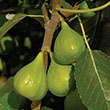
Lattarula' figs are a type of Italian honey fig. These fruits have a sweet, amber flesh and are great for fresh eating, drying and canning. They produce one crop in late-July and one in mid-September. They will average at 8-10' tall and 6-8' wide.
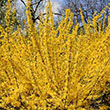
Border forsythia is a vigorous grower with an upright, rounded habit that will quickly reach 8-10' tall and 10-12' wide. Its vibrant yellow blooms will appear in mid-spring, before the foliage appears, and will last for a couple of weeks. This variety can handle partial shade, but will bloom better in a full sun environment. Can be pruned back in late spring or early summer after blooms have been spent.

The 'Lynwood Gold' is a large variety that will quickly reach 8-10' tall and wide. It produces masses of vibrant, golden-yellow flowers in late winter or early spring that appear before spring foliage emerges.
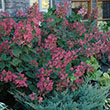
Pink Diamond' has white blooms that blush with deep pink as they age. Grows 8-10' tall and wide.
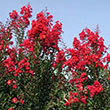
This reblooming variety provides an explosion of color all summer long. The 'Double Dynamite' produces intense, cherry-red blossoms that appear in early summer and will persist throughout the season. Dark purple foliage emerges and ages to dark green.
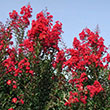
This reblooming variety provides an explosion of color all summer long. The 'Double Dynamite' produces intense, cherry-red blossoms that appear in early summer and will persist throughout the season. Dark purple foliage emerges and ages to dark green.
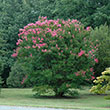
The 'Hopi' is a desirable specimen tree due to its year-round interest. It produces massive clusters of pink blooms in the summertime that are followed by orange, yellow and red fall foliage. Creamy, exfoliating bark adds winter interest. This compact variety will reach 8-10' tall and wide and is great for smaller garden spaces.

Height: 15 feet
Spread: 15 feet
Sunlight: full sun partial shade
Hardiness Zone: 6a
Other Names: Crape Myrtle, Crepe Myrtle
Description:
This exceptionally cold hardy, semi-dwarf variety is covered in frilly pink blooms in summer, followed by deep red fall foliage; a captivating focal point for the garden or border
Ornamental Features:
Hopi Crapemyrtle is clothed in stunning panicles of pink frilly flowers at the ends of the branches from early to late summer. It has attractive dark green deciduous foliage which emerges coppery-bronze in spring. The oval leaves are highly ornamental and turn dark red in fall.
Landscape Attributes:
Hopi Crapemyrtle is a dense multi-stemmed deciduous shrub with a more or less rounded form. Its relatively fine texture sets it apart from other landscape plants with less refined foliage.
This is a relatively low maintenance shrub, and is best pruned in late winter once the threat of extreme cold has passed. It has no significant negative characteristics.
Hopi Crapemyrtle is recommended for the following landscape applications:
- Accent
- Mass Planting
- Hedges/Screening
- General Garden Use
- Container Planting
Planting & Growing:
Hopi Crapemyrtle will grow to be about 15 feet tall at maturity, with a spread of 15 feet. It has a low canopy with a typical clearance of 2 feet from the ground, and is suitable for planting under power lines. It grows at a fast rate, and under ideal conditions can be expected to live for 50 years or more.
This shrub does best in full sun to partial shade. It prefers to grow in average to moist conditions, and shouldn't be allowed to dry out. It is very fussy about its soil conditions and must have rich, acidic soils to ensure success, and is subject to chlorosis (yellowing) of the foliage in alkaline soils. It is highly tolerant of urban pollution and will even thrive in inner city environments. This particular variety is an interspecific
hybrid.
Hopi Crapemyrtle makes a fine choice for the outdoor landscape, but it is also well-suited for use in outdoor pots and containers. Because of its height, it is often used as a 'thriller' in the 'spiller-thriller-filler' container combination; plant it near the center of the pot, surrounded by smaller plants and those that spill over the edges. It is even sizeable enough that it can be grown alone in a suitable container. Note that when grown in a container, it may not perform exactly as indicated on the tag - this is to be expected. Also note that when growing plants in outdoor containers and baskets, they may require more frequent waterings than they would in the yard or garden.
37 found, showing page 2 of 3